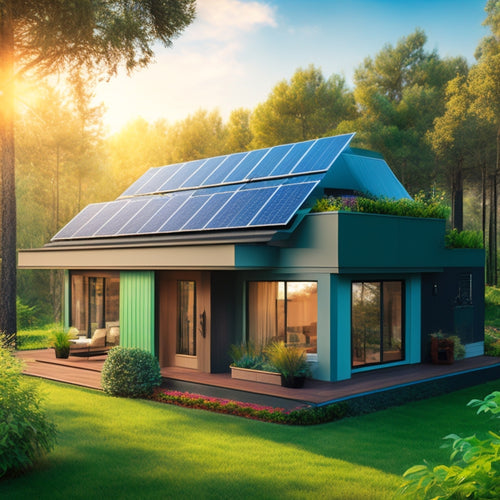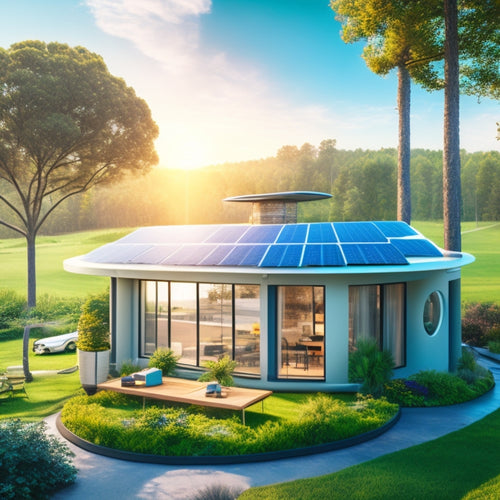
10 Water-Saving Sprinkler Solutions for Drought-Prone Regions
Share
You're looking for innovative solutions to optimize your irrigation system in drought-prone regions. You'll want to contemplate weather-based smart watering, which adjusts schedules based on real-time weather data, and soil moisture sensor technology, which provides accurate moisture readings for effective irrigation management. Other solutions include rain sensor technology, evapotranspiration monitoring tools, and smart irrigation controllers that optimize watering schedules. You may also want to investigate water-efficient irrigation systems, low-flow sprinkler nozzles, and drought-tolerant lawn alternatives. By implementing these solutions, you'll be well on your way to minimizing water waste and reducing your environmental footprint - and that's just the beginning.
Key Takeaways
- Utilize low-flow sprinkler nozzles to decrease water usage by up to 20% and improve sprinkler efficiency.
- Employ smart controllers to optimize watering schedules and prevent overwatering based on real-time weather data.
- Incorporate rain sensors to pause watering during rainfall, reducing water waste by up to 30%.
- Install drip irrigation systems for efficient water delivery, minimizing evaporation and runoff.
- Adopt soaker hoses for targeted moisture application, reducing water waste and promoting healthy root growth.
Weather-Based Smart Watering
Most residential and commercial properties rely on traditional timers to dictate their watering schedules, but weather-based smart watering takes a more flexible approach.
You can optimize your irrigation system to respond to real-time weather patterns, ensuring you're not overwatering during rainfall or under-watering during dry spells. By integrating weather data into your watering schedule, you'll enhance irrigation efficiency and reduce waste.
Weather-based smart watering considers factors like temperature, humidity, and precipitation to determine the ideal watering schedule for your specific climate.
To maximize energy production and reduce waste, it's crucial to optimize solar panel array design and select energy-efficient equipment.
This approach allows you to take control of your water usage, making the most of this precious resource. By adapting to changing weather conditions, you'll enjoy a lush, healthy environment while minimizing your environmental footprint.
Soil Moisture Sensor Technology
You'll get the most out of your water-saving sprinkler system when you're working with accurate moisture readings, which is where soil moisture sensor technology comes in.
By leveraging renewable energy sources solar-powered fast charging in irrigation systems, farmers can reduce their carbon footprint and improve energy distribution.
Wireless sensor capabilities allow you to monitor soil conditions from anywhere, giving you greater control over your watering schedule.
Accurate Moisture Readings Matter
Measuring soil moisture accurately is vital in optimizing water usage, as it directly impacts the effectiveness of irrigation systems. When you have precise moisture readings, you can guarantee that your soil is receiving the right amount of water, reducing waste and conserving this important resource.
This is especially essential in drought-prone regions where water is scarce. Implementing renewable energy solutions, such as energy storage systems, can also contribute to a more sustainable irrigation system. By combining accurate moisture readings with clean energy, you can greatly reduce your environmental footprint.
Improved irrigation efficiency: You can optimize your irrigation schedule to provide the right amount of water at the right time.
Enhanced moisture retention: Accurate readings help you identify areas where soil moisture is lacking, allowing you to adjust your irrigation strategy to improve retention.
Increased crop yields: Proper watering leads to healthier plants and higher yields.
Reduced water waste: You'll avoid overwatering, which saves water and reduces your environmental impact.
Better decision-making: With precise moisture readings, you can make informed decisions about irrigation and soil management.
Wireless Sensor Capabilities
Wireless soil moisture sensors have revolutionized the way farmers and gardeners monitor and manage soil moisture levels. You can now seamlessly integrate these sensors into your existing irrigation systems, allowing for real-time monitoring and automated decision-making.
With remote monitoring capabilities, you can check soil moisture levels from anywhere, at any time, and receive alerts when levels drop below ideal thresholds. This enables you to make data-driven decisions, reducing water waste and ensuring your crops receive the right amount of moisture.
By leveraging fast charging infrastructure high-power charging, farmers can also reduce downtime and increase efficiency in their irrigation systems. Sensor integration is easy and flexible, allowing you to customize your system to fit your specific needs.
Real-Time Data Insights
As soil moisture levels fluctuate, real-time data observations become essential for informed irrigation decisions. You need to stay on top of changing soil conditions to optimize water usage.
Soil moisture sensor technology provides you with real-time data revelations to make data-driven decisions. Implementing load management strategies, such as those used in EV charging stations, can help avoid peak charges and reduce energy waste energy management strategies.
This technology enables you to:
- Monitor soil moisture levels remotely through mobile apps or web platforms
- Receive alerts and notifications when soil moisture levels reach critical points
- Analyze historical data to identify trends and patterns
- Integrate with weather forecasts for more accurate irrigation scheduling
- Employ data analytics to create irrigation forecasts and optimize water usage
With real-time data revelations, you can take control of your irrigation system and make informed decisions to conserve water and reduce waste.
Rainfall Shutoff Devices Work
You've probably wondered whether rainfall shutoff devices are worth the investment - and the answer is yes.
These devices automatically shut off your irrigation system when it rains, ensuring you're not wasting water. By analyzing local rainfall patterns, they optimize irrigation efficiency. This means you'll save water and reduce your water bill.
Plus, you'll be doing your part to conserve this precious resource. With rainfall shutoff devices, you can rest easy knowing your lawn is getting the right amount of water, without overwatering.
This technology is especially beneficial in drought-prone regions, where every drop counts. By installing a rainfall shutoff device, you'll be taking a significant step towards responsible water management and a more sustainable future.
Drought-Tolerant Lawn Alternatives
You're looking for ways to reduce your lawn's water consumption, and that's where drought-tolerant lawn alternatives come in.
You can consider low water groundcovers that require minimal irrigation, or opt for drought-resistant grass options that can thrive with less water.
Alternatively, you might design a succulent lawn that's not only water-efficient but also visually striking.
Low Water Groundcovers
By replacing traditional lawns with low water groundcovers, homeowners can drastically reduce their water consumption while still achieving a lush, verdant appearance.
This shift towards xeriscaping benefits not only the environment but also your wallet, as it eliminates the need for frequent watering and maintenance.
Some popular low water groundcovers to take into account are:
- Native plant groundcovers like creeping thyme, which require minimal watering and care
- Dymondia margaretae, a drought-tolerant succulent that forms a dense mat
- Sedum, a low-growing succulent that stores water in its leaves
- Yarrow, a flowering perennial that attracts pollinators
- Vinca minor, an evergreen groundcover that thrives in shade
Drought-Resistant Grass Options
Embracing drought-resistant grass options can greatly reduce water consumption, an essential step towards water conservation.
You can opt for native grass varieties that are naturally adapted to thrive in drought-prone regions. These grasses require minimal watering, mowing, and fertilization, reducing turfgrass maintenance.
Buffalo grass, blue grama, and Bermuda grass are popular choices for their low water requirements. By choosing drought-resistant grass, you'll not only conserve water but also reduce your lawn care expenses.
Additionally, these grasses are more resistant to pests and diseases, reducing the need for chemical treatments.
Succulent Lawn Designs
Succulent lawn designs offer an innovative approach to water conservation, taking drought-tolerant landscaping to the next level. You can create a low-maintenance, water-efficient lawn that's perfect for drought-prone regions.
Succulent varieties like aloe, agave, and echeveria are ideal for lawn aesthetics, providing a unique, modern look. They're also incredibly resilient, requiring minimal watering and care.
Here are some benefits of succulent lawn designs:
-
Low water consumption: Succulents store water in their leaves, stems, or roots, reducing the need for frequent watering.
-
Drought tolerance: Succulents can survive with minimal rainfall, making them perfect for areas with water restrictions.
-
Pest and disease resistance: Succulents have natural defenses against pests and diseases, reducing the need for chemicals.
-
Easy maintenance: Succulents require minimal pruning, mowing, and fertilization.
-
Year-round interest: Succulents provide visual interest throughout the year, even in winter.
Low-Flow Sprinkler Nozzles
One of the most effective ways to reduce water waste in irrigation systems is to install low-flow sprinkler nozzles, which can decrease water usage by up to 20%.
By upgrading to these nozzles, you'll improve sprinkler efficiency and reduce the amount of water wasted due to evaporation, runoff, or overspray.
To get the most out of your low-flow nozzles, make precise nozzle adjustments to guarantee the right amount of water is applied to your lawn or garden.
This will also help prevent overwatering, which can lead to shallow root growth and increased susceptibility to disease.
With low-flow sprinkler nozzles, you'll enjoy significant water savings without sacrificing the health of your greenery.
Water-Efficient Irrigation Systems
You're looking for ways to optimize your irrigation system's water usage, and that's where water-efficient irrigation systems come in.
By incorporating smart technologies, you can greatly reduce water waste and guarantee your plants receive the right amount of water at the right time.
You'll want to take into account smart irrigation controllers, rain sensor technology, and soil moisture monitoring to create a customized watering schedule that meets your environment's unique needs.
Smart Irrigation Controllers
Integrating smart irrigation controllers into your water-efficient irrigation systems can alter the manner in which you manage your water usage.
These advanced controllers optimize your smart watering schedules, ensuring you're not over- or under-watering your environment.
With automated irrigation, you can:
- Customize watering schedules based on soil type, plant species, and weather patterns
- Receive real-time notifications of system issues or water waste
- Monitor and adjust water usage remotely using mobile apps
- Integrate with weather stations and soil moisture sensors for precise watering decisions
- Reduce water waste and lower your water bills
Rain Sensor Technology
Take control of your irrigation system with rain sensor technology, which kicks in to pause watering sessions during rainy days, eliminating unnecessary water waste. This innovative feature guarantees you're not overwatering your lawn or garden, saving you money and conserving this precious resource.
| Rain Sensor Benefits | Description | Installation Tips |
|---|---|---|
| Water Conservation | Reduces water waste by up to 30% | Install sensors in an open area, away from buildings and trees |
| Increased Efficiency | Automatically adjusts watering schedules | Connect sensors to your irrigation controller for seamless integration |
| Cost Savings | Lowers your water bill and extends system lifespan | Regularly clean and inspect sensors for peak performance |
| Environmentally Friendly | Helps maintain a healthy ecosystem | Consider wireless sensors for easy installation and minimal maintenance |
Soil Moisture Monitoring
Your soil's moisture levels play an important role in determining the right amount of water it needs, and soil moisture monitoring is a crucial component of water-efficient irrigation systems.
By tracking soil moisture, you can guarantee that your plants receive the right amount of water, reducing waste and conserving this precious resource.
Soil moisture monitoring helps you:
- Optimize irrigation techniques for improved soil health and moisture retention
- Implement effective drought management strategies through climate adaptation
- Inform environment design and plant selection decisions for sustainable practices
- Enhance garden planning for water conservation
- Make data-driven decisions for efficient water use
WiFi-Enabled Sprinkler Controllers
With the rise of smart home technology, WiFi-enabled sprinkler controllers have become an attractive solution for homeowners looking to optimize their water usage.
You can now control and monitor your sprinkler system remotely using a mobile app, receiving real-time updates on soil moisture levels and weather conditions. This integration allows you to adjust your watering schedule accordingly, ensuring you're not overwatering or underwatering your lawn.
Sensor integration enables the controller to automatically adjust watering schedules based on soil moisture levels, further reducing waste.
Evapotranspiration Monitoring Tools
About 70% of a typical home's water usage goes towards outdoor irrigation, making it a prime area for optimization. To maximize water efficiency, you'll want to monitor evapotranspiration (ET) rates, which measure how much water your plants are using.
ET monitoring tools help you understand your plants' water needs, so you can adjust your irrigation schedule accordingly.
- ET sensors measure soil moisture, temperature, and humidity to calculate the evapotranspiration rate
- Weather stations provide data on temperature, humidity, wind speed, and solar radiation to estimate ET
- Satellite imagery analyzes vegetation health and soil moisture to estimate water usage
- Soil probes measure soil moisture and temperature at different depths
- Mobile apps use climate data and plant water requirements to estimate ET rates, providing you with actionable knowledge to minimize your climate impact
Smart Watering Schedule Optimization
Armed with evapotranspiration data, you can now enhance your irrigation schedule to guarantee plants receive the right amount of water at the right time. This smart watering schedule enhancement promotes water conservation and elevates irrigation efficiency. By analyzing the data, you can identify the ideal watering frequency, duration, and timing to meet your plants' specific needs.
| Watering Schedule | Benefits |
|---|---|
| Morning watering | Reduces evaporation, minimizes fungal growth |
| Drip irrigation | Delivers water directly to roots, reduces runoff |
| Cycle-and-soak watering | Allows soil to absorb water, reducing runoff |
| Weather-based adjustments | Adjusts watering schedule based on real-time weather data |
Gray Water Recycling Systems
Every gallon of water you conserve counts, and gray water recycling systems can help you do just that. By reusing water from sinks, showers, and washing machines, you can greatly reduce your water consumption.
Gray water recycling systems use gray water filtration to treat and reuse water for irrigation, toilet flushing, and other non-potable purposes.
Here are some benefits of implementing gray water recycling systems:
- Reduce water bills and dependence on municipal water supplies
- Increase water availability for sustainable landscaping and irrigation
- Decrease wastewater generation and strain on sewage systems
- Enhance water security and independence
- Contribute to a more sustainable and environmentally-friendly lifestyle
Frequently Asked Questions
Can I Install Water-Saving Sprinkler Systems Myself or Hire a Pro?
You can opt for DIY installation, but consider your skill and time; if unsure, hire a pro for professional assistance, ensuring a flawless setup that maximizes water efficiency and minimizes potential pitfalls.
Are Water-Efficient Irrigation Systems Compatible With Existing Hardware?
You'll be relieved to know that most water-efficient irrigation systems are compatible with your existing hardware, making irrigation upgrades a breeze, but it's crucial to check system compatibility before making the switch to guarantee a seamless change.
Do Smart Watering Systems Work With Wells or Only Municipal Water?
You're likely aware that 70% of the world's freshwater is used for agriculture. When it comes to smart watering systems, you'll be relieved to know they're compatible with both municipal water and well water, thanks to advanced smart technology integration, giving you the freedom to choose.
Can Drought-Tolerant Lawn Alternatives Be Used in Shady Areas?
You'll find drought-tolerant lawn alternatives suitable for shady areas, such as shade-tolerant grasses like St. Augustine or Buffalo grass, and ground cover options like thyme or creeping juniper, which require minimal watering and maintenance.
Are Water-Saving Sprinkler Solutions Eligible for Government Rebates?
You're probably wondering if you can score a sweet rebate on those water-saving sprinklers you've been eyeing - and the answer is, yes! Many governments offer rebates on eligible sprinkler types, like drip irrigation and smart controllers, to encourage sustainable landscaping.
Related Posts
-

3 Green HVAC Filters for Solar-Powered Homes
When outfitting your solar-powered home with an HVAC system, you'll want to choose filters that align with your commi...
-

Gamify Your Home's Energy Generation and Savings
You're taking the next step in optimizing your home's energy generation and savings by utilizing the power of gamific...
-

Transform Your Outdoor Space With Recycled Plastic Lumber
By incorporating recycled plastic lumber into your outdoor design, you're not just building a deck or installing a fe...


